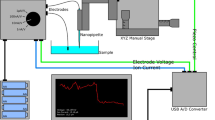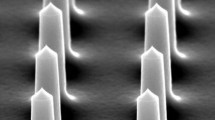Abstract
We present a non-fluidic pronuclear injection method using a silicon microchip “nanoinjector” composed of a microelectromechanical system with a solid, electrically conductive lance. Unlike microinjection which uses fluid delivery of DNA, nanoinjection electrically accumulates DNA on the lance, the DNA-coated lance is inserted into the pronucleus, and DNA is electrically released. We compared nanoinjection and microinjection side-by-side over the course of 4 days, injecting 1,013 eggs between the two groups. Nanoinjected zygotes had significantly higher rates of integration per injected embryo, with 6.2 % integration for nanoinjected embryos compared to 1.6 % integration for microinjected embryos. This advantage is explained by nanoinjected zygotes’ significantly higher viability in two stages of development: zygote progress to two-cell stage, and progress from two-cell stage embryos to birth. We observed that 77.6 % of nanoinjected zygotes proceeded to two-cell stage compared to 54.7 % of microinjected zygotes. Of the healthy two-cell stage embryos, 52.4 % from the nanoinjection group and 23.9 % from the microinjected group developed into pups. Structural advantages of the nanoinjector are likely to contribute to the high viability observed. For instance, because charge is used to retain and release DNA, extracellular fluid is not injected into the pronucleus and the cross-sectional area of the nanoinjection lance (0.06 µm2) is smaller than that of a microinjection pipette tip (0.78 µm2). According to results from the comparative nanoinjection versus microinjection study, we conclude that nanoinjection is a viable method of pronuclear DNA transfer which presents viability advantages over microinjection.





Similar content being viewed by others
References
Aten Q, Jensen B, Burnett S, Howell LL (2011) Electrostatic accumulation and release of DNA using a micromachined lance. J MEMS 20:1449–1461
Audubert R, Mende S (1960) The principles of electrophoresis. Macmillan, New York
Billings LM, Oddo S, Green KN, McGaugh JL, LaFerla FM (2005) Intraneuronal Abeta causes the onset of early Alzheimer’s disease-related cognitive deficits in transgenic mice. Neuron 45:675–688
Brinster RL, Chen HY, Trumbauer ME, Yagle MK, Palmiter RD (1985) Factors affecting the efficiency of introducing foreign DNA into mice by microinjecting eggs. Proc Natl Acad Sci USA 82:4438–4442
Brown L, Cai T, DasGupta A (2001) Interval estimation for a binomail proportion. Stat Sci 16:101–133
Burnett SH, Kershen EJ, Zhang J, Zeng L, Straley SC, Kaplan AM, Cohen DA (2004) Conditional macrophage ablation in transgenic mice expressing a Fas-based suicide gene. J Leukoc Biol 75:612–623
Chan AW, Kukolj G, Skalka AM, Bremel RD (1999) Timing of DNA integration, transgenic mosaicism, and pronuclear microinjection. Mol Reprod Dev 52:406–413
Chen X, Kis A, Zettl A, Bertozzi CR (2007) A cell nanoinjector based on carbon nanotubes. Proc Natl Acad Sci USA 104:8218–8222
Chida K, Sueyoshi R, Kuroki T (1998) Efficient and stable gene transfer following microinjection into nuclei of synchronized animal cells progressing from G1/S boundary to early S phase. Biochem Biophys Res Commun 249:849–852
Cuerrier CM, Lebel R, Grandbois M (2007) Single cell transfection using plasmid decorated AFM probes. Biochem Biophys Res Commun 355:632–636
Dai JS, Jones JR (1999) Mobility in metamorphic mechanisms of foldable/erectable kinds. J Mech Des 121:375–382
David RA, Jensen BD, Black JL, Burnett SH, Howell LL (2010) Modeling and experimental validation of DNA motion in uniform and nonuniform DC electric fields. J Nanotechnol Eng Med 1:041007
David RA, Jensen BD, Black JL, Burnett SH, Howell LL (2011) Effects of dissimilar electrode materials and electrode position on DNA motion during electrophoresis. J Nanotechnol Eng Med 2:021014
Everitt B (1992) The analysis of contigency tables. Chapman & Hall, New York
Gimbel DA, Nygaard HB, Coffey EE, Gunther EC, Lauren J, Gimbel ZA, Strittmatter SM (2010) Memory impairment in transgenic Alzheimer mice requires cellular prion protein. J Neurosci 30:6367–6374
Goldstein AS, Huang J, Guo C, Garraway IP, Witte ON (2010) Identification of a cell of origin for human prostate cancer. Science 329:568–571
Gordon JW, Ruddle FH (1981) Integration and stable germ line transmission of genes injected into mouse pronuclei. Science 214:1244–1246
Gordon JW, Scangos GA, Plotkin DJ, Barbosa JA, Ruddle FH (1980) Genetic transformation of mouse embryos by microinjection of purified DNA. Proc Natl Acad Sci USA 77:7380–7384
Gossler A, Doetschman T, Korn R, Serfling E, Kemler R (1986) Transgenesis by means of blastocyst-derived embryonic stem cell lines. Proc Natl Acad Sci USA 83:9065–9069
Howell LL (2001) Compliant mechanisms. Wiley, New York
Jensen KA, Lusk CP, Howell LL (2006) An XYZ micromanipulator with three translational degrees of freedom. Robotica 24:305–314
Kirak O, Frickel EM, Grotenbreg GM, Suh H, Jaenisch R, Ploegh HL (2010) Transnuclear mice with predefined T cell receptor specificities against Toxoplasma gondii obtained via SCNT. Science 328:243–248
Lois C, Hong EJ, Pease S, Brown EJ, Baltimore D (2002) Germline transmission and tissue-specific expression of transgenes delivered by lentiviral vectors. Science 295:868–872
Nagy A, Gertenstein M, Vintersten K, Behringer R (2003) Manipulating the mouse embryo: a laboratory manual. Cold Spring Harbor Laboratory Press, Cold Spring Harbor
Park S, Kim YS, Kim WB, Jon S (2009) Carbon nanosyringe array as a platform for intracellular delivery. Nano Lett 9:1325–1329
Pease S, Saunders T (2011) Advanced protocols for animal transgenesis. Springer, Berlin
Ryan SO, Vlad AM, Islam K, Gariepy J, Finn OJ (2009) Tumor-associated MUC1 glycopeptide epitopes are not subject to self-tolerance and improve responses to MUC1 peptide epitopes in MUC1 transgenic mice. Biol Chem 390:611–618
Shalek AK, Robinson JT, Karp ES, Lee JS, Ahn DR, Yoon MH, Sutton A, Jorgolli M, Gertner RS, Gujral TS et al (2010) Vertical silicon nanowires as a universal platform for delivering biomolecules into living cells. Proc Natl Acad Sci USA 107:1870–1875
Steward TA, Wagner EF, Mintz B (1982) Human beta-globin gene sequences injected into mouse eggs, retained in adults, and transmitted to progeny. Science 217:1046–1048
Strowig T, Rongvaux A, Rathinam C, Takizawa H, Borsotti C, Philbrick W, Eynon EE, Manz MG, Flavell RA (2011) Transgenic expression of human signal regulatory protein alpha in Rag2−/−gamma(c)−/− mice improves engraftment of human hematopoietic cells in humanized mice. Proc Natl Acad Sci USA 108:13218–13223
Upton GJG (1992) Fisher’s exact test. J R Stat Soc A Stat 155:395–402
Wall RJ (2001) Pronuclear microinjection. Cloning Stem Cells 3:209–220
Wurtele H, Little KC, Chartrand P (2003) Illegitimate DNA integration in mammalian cells. Gene Ther 10:1791–1799
Yamauchi Y, Doe B, Ajduk A, Ward MA (2007) Genomic DNA damage in mouse transgenesis. Biol Reprod 77:803–812
Acknowledgments
The authors would like to thank the students of the Brigham Young University Department of Mechanical Engineering Compliant Mechanisms Research Group (CMR) including SEM work by Gregory Teichert and Melanie Easter. We acknowledge the work of technician, Robert Rawle, and the students of the Brigham Young University Department of Molecular & Microbiology Burnett Research Laboratory. We also thank Phil Clair and Julie Tomlin of the University of Utah Transgenic and Gene Targeting Mouse Core for their excellent microinjection and surgical skills throughout this project. The authors recognize the funding support provided by Crocker Ventures, LLC and NanoInjection Technologies, LLC. This material is based upon work supported in part by the National Science Foundation under Grants No. CMS-0428532 and No. CMMI-0800606. Any opinions, findings, and conclusions or recommendations expressed in this material are those of the author(s) and do not necessarily reflect the views of the National Science Foundation. Parts of this work have been presented at the 9th Transgenic Technology Meeting (abstract 42; March 2010) and the 10th Transgenic Technology Meeting (abstract #48; October 2011).
Author information
Authors and Affiliations
Corresponding author
Electronic supplementary material
Below is the link to the electronic supplementary material.
Online Resources 1 - Computer animation video of pronuclear nanoinjection. This video demonstrates the movement of the nanoinjector from its lowered position to an elevated position for injection. A close up view demonstrates the size of the lance in respect to the zygote and depicts the smooth motion of the lance entering and exiting the cell. Supplementary material 1 (WMV 8716 kb)
Online Resources 2 – Live video of pronuclear nanoinjection on a living mouse zygote. This video shows nanoinjection being performed on a living zygote. The zygote is held in position with a holding pipette and has been oriented to bring the pronuclei into the same plane as the lance. The appearance of the cell and the visibility of the pronuclei differ from images of typical inverted microscopy videos due to the use of an overhead camera for this video (refracted light and the curvature of the meniscus of fluid covering the nanoinjection chip causes this effect); therefore, the location of the pronuclei are indicated prior to nanoinjection with the lance. A notable feature of nanoinjection is the ease with which the lance penetrates the zona pellucida, the cell membrane, and the pronucleus, resulting in only very subtle inward depression of these membranes during penetration compared to what is typically seen with microinjection. Supplementary material 2 (WMV 13432 kb)
11248_2012_9610_MOESM3_ESM.eps
Online Resources 3 – In vitro data confirms that nanoinjection maintains zygote viability compared to untreated zygotes. Results from the in vivo study did not indicate statistical difference between nanoinjected and untreated zygotes able to proceed to the 2-cell stage (Fig 5B). This Online Resources figure presents data from numerous in vitro studies as a second data set to confirm that the viability to the 2-cell stage is maintained in nanoinjected cells. We felt that this in vitro data was valuable to confirm in vivo work presented in the main body of this research for two reasons. First, the in vivo study only included 31 zygotes in the untreated controls compared to 371 in the nanoinjection group, but for in vitro studies, we collected data over more weeks, which includes more zygotes. A higher number in the untreated controls of the in vitro studies offers greater weight to the statistical interpretation, as is apparent when one compares the confidence intervals in Fig 5B to those shown in this figure. Second, we had access to a different strain of mouse for in vitro data (CD1 outbred) compared to in vivo data (C57Bl/6 J × CBA/J F1), yet the results demonstrate the ability of the nanoinjection process to maintain maximum viability in both strains of mice. The difference in the viability of untreated and nanoinjected embryos is not statistically significant when observing a large number of untreated and nanoinjected zygotes over multiple in vitro experiments. Plotted confidence intervals are Jeffreys 95% confidence intervals for binomial proportions. Supplementary material 3 (EPS 89 kb)
Rights and permissions
About this article
Cite this article
Aten, Q.T., Jensen, B.D., Tamowski, S. et al. Nanoinjection: pronuclear DNA delivery using a charged lance. Transgenic Res 21, 1279–1290 (2012). https://doi.org/10.1007/s11248-012-9610-6
Received:
Accepted:
Published:
Issue Date:
DOI: https://doi.org/10.1007/s11248-012-9610-6




